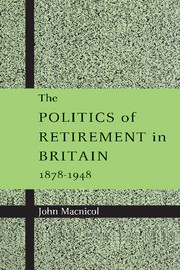Book contents
- Frontmatter
- Contents
- List of tables
- Acknowledgements
- Part I The campaign for old age pensions
- Part II Contributory pensions
- Part III The debate on retirement pensions
- Part IV The ‘Beveridge revolution’
- 13 The pensions crisis of the late 1930s
- 14 The Treasury enquiry and the 1940 Act
- 15 The origins and working of the Beveridge Committee
- 16 After the Beveridge Report, 1942–1948
- 17 Conclusion
- Index
14 - The Treasury enquiry and the 1940 Act
Published online by Cambridge University Press: 01 October 2009
- Frontmatter
- Contents
- List of tables
- Acknowledgements
- Part I The campaign for old age pensions
- Part II Contributory pensions
- Part III The debate on retirement pensions
- Part IV The ‘Beveridge revolution’
- 13 The pensions crisis of the late 1930s
- 14 The Treasury enquiry and the 1940 Act
- 15 The origins and working of the Beveridge Committee
- 16 After the Beveridge Report, 1942–1948
- 17 Conclusion
- Index
Summary
‘I do not think we can contemplate this kind of thing either now or in the future’, was one anonymous Treasury official's verdict on the TUC proposals. But this was wishful thinking. By 1939, the pressure begun by Labour in the mid-1950s had built up to a climax, drawing in support from all sides until pensions had become virtually an all-party issue. The growing confidence of the broad ‘middle opinion’ movement was one factor. Another was the imminence of a general election (which would have had to be held in 1940): politicians of all parties realised that there was powerful feeling in their constituencies on the pensions issue. Increasing concern was felt by those Conservatives with narrow majorities, or with seats in the north of England where unemployment was acute and pensioner poverty consequently greater. Electorally, the National government was not an impregnable fortress, and there was no guarantee how long it could continue. Once it collapsed, conventional party politics could return with a vengeance: there could well be a replay of 1922–4, with social reform high on the agenda of each party's election promises. In order to avoid such a collapse, some concessions would have to be made on the pensions front, if only to take the wind out of Labour's sails. This was the Treasury's real dilemma in 1939: small concessions might produce the ‘domino effect’, and inexorably rising expenditure; no concessions at all might be electorally disastrous for the Chamberlain government. As we shall see, the senior civil servants believed they could bluff things out; by contrast, the politicians were much more responsive to electoral pressures, and took fright.
- Type
- Chapter
- Information
- The Politics of Retirement in Britain, 1878–1948 , pp. 325 - 346Publisher: Cambridge University PressPrint publication year: 1998



